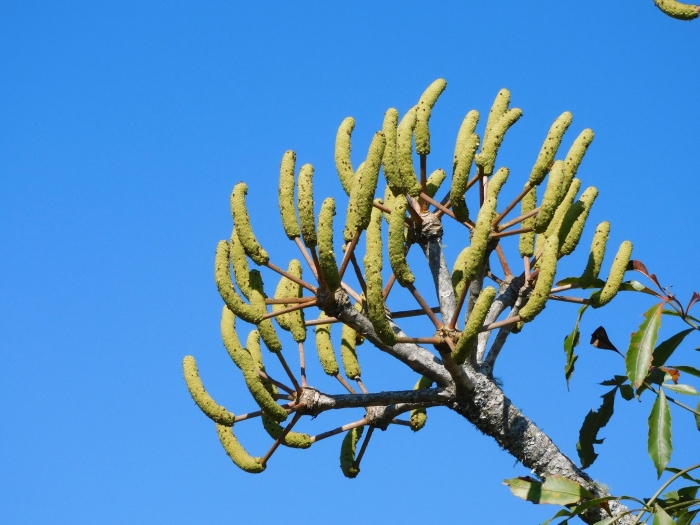Spiked Cabbage Tree
(Cussonia spicata)
Spiked Cabbage Tree (Cussonia spicata)
/
/

Andrew Deacon
Public Domain
Image By:
Andrew Deacon
Recorded By:
Copyright:
Public Domain
Copyright Notice:
Photo by: Andrew Deacon | License Type: Public Domain | License URL: http://creativecommons.org/publicdomain/zero/1.0/ | Rights Holder: Andrew Deacon | Publisher: iNaturalist | Date Created: 2021-05-13T13:26:11-07:00 |
















































Estimated Native Range
Summary
Cussonia spicata, commonly known as Spiked Cabbage Tree, is an evergreen tree native to the woodlands, grasslands, and rocky outcrops in Eastern and Southern Africa. It is a member of the Araliaceae family and thrives in regions with a moist climate, although it is also quite drought-tolerant once established. This species typically grows to a height of up to 15 meters with a sturdy trunk and a rounded, spreading canopy. The leaves are large, palmate, and blue-green, forming distinctive rounded heads at the ends of thick branches. The "spicata" in its name refers to the spike-like arrangement of its small greenish-yellow flowers, which bloom in high-density clusters. These flowers are followed by small, fleshy fruits that attract birds.
The Spiked Cabbage Tree is valued for its architectural form and the unique texture of its foliage, making it a striking feature in gardens and landscapes. It is often used as a focal point in tropical and subtropical gardens, and its ability to withstand dry conditions makes it suitable for xeriscaping. In cultivation, it prefers full sun to part shade and requires well-drained soil. While it tolerates a range of soil types, it performs best in soils with medium drainage. It is relatively low maintenance but can be susceptible to root rot if overwatered. There are no widely recognized cultivars of this species, but its natural form is highly ornamental.CC BY-SA 4.0
The Spiked Cabbage Tree is valued for its architectural form and the unique texture of its foliage, making it a striking feature in gardens and landscapes. It is often used as a focal point in tropical and subtropical gardens, and its ability to withstand dry conditions makes it suitable for xeriscaping. In cultivation, it prefers full sun to part shade and requires well-drained soil. While it tolerates a range of soil types, it performs best in soils with medium drainage. It is relatively low maintenance but can be susceptible to root rot if overwatered. There are no widely recognized cultivars of this species, but its natural form is highly ornamental.CC BY-SA 4.0
Plant Description
- Plant Type: Tree
- Height: 25-40 feet
- Width: 15-30 feet
- Growth Rate: Moderate
- Flower Color: Green, Yellow
- Flowering Season: Spring, Summer
- Leaf Retention: Evergreen
Growth Requirements
- Sun: Full Sun, Part Shade
- Water: Medium
- Drainage: Medium
Common Uses
Drought Tolerant, Low Maintenance, Street Planting
Natural Habitat
Woodlands, grasslands, and rocky outcrops in Eastern and Southern Africa with a moist climate
Other Names
Common Names: Lowveld Cabbage Tree, Common Cabbage Tree
Scientific Names: , Cussonia spicata, Cussonia kraussii, Cussonia boivinii, Cussonia calophylla, Cussonia quercifolia, Cussonia triptera,
GBIF Accepted Name: Cussonia spicata Thunb.